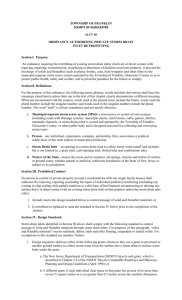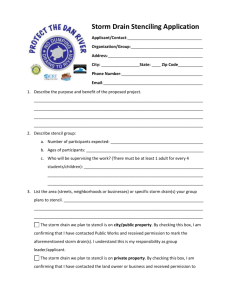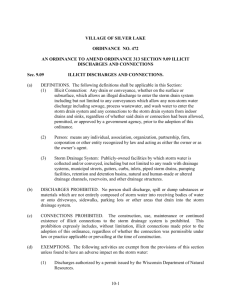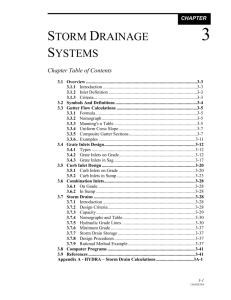File
advertisement
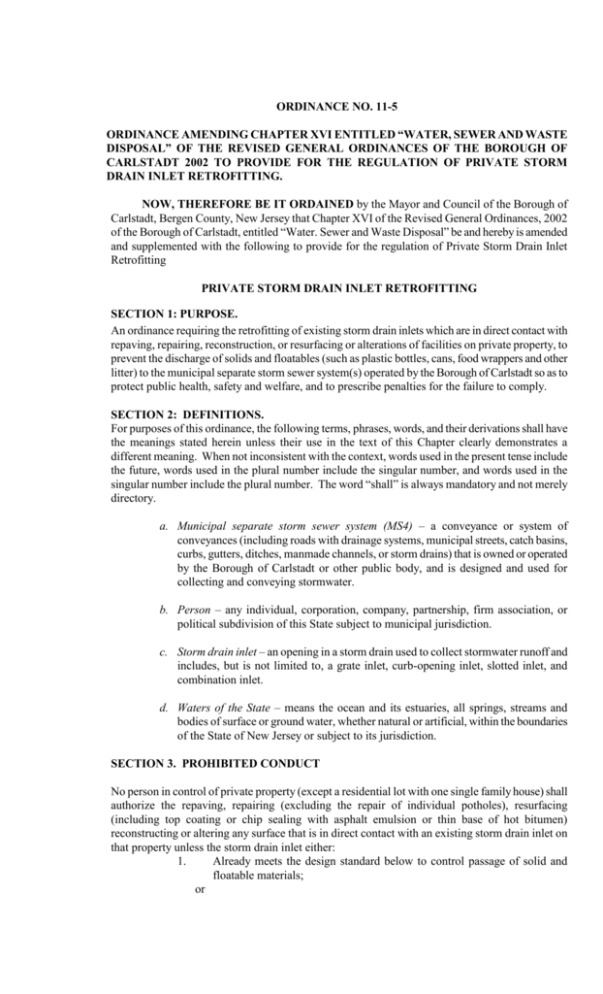
ORDINANCE NO. 11-5 ORDINANCE AMENDING CHAPTER XVI ENTITLED “WATER, SEWER AND WASTE DISPOSAL” OF THE REVISED GENERAL ORDINANCES OF THE BOROUGH OF CARLSTADT 2002 TO PROVIDE FOR THE REGULATION OF PRIVATE STORM DRAIN INLET RETROFITTING. NOW, THEREFORE BE IT ORDAINED by the Mayor and Council of the Borough of Carlstadt, Bergen County, New Jersey that Chapter XVI of the Revised General Ordinances, 2002 of the Borough of Carlstadt, entitled “Water. Sewer and Waste Disposal” be and hereby is amended and supplemented with the following to provide for the regulation of Private Storm Drain Inlet Retrofitting PRIVATE STORM DRAIN INLET RETROFITTING SECTION 1: PURPOSE. An ordinance requiring the retrofitting of existing storm drain inlets which are in direct contact with repaving, repairing, reconstruction, or resurfacing or alterations of facilities on private property, to prevent the discharge of solids and floatables (such as plastic bottles, cans, food wrappers and other litter) to the municipal separate storm sewer system(s) operated by the Borough of Carlstadt so as to protect public health, safety and welfare, and to prescribe penalties for the failure to comply. SECTION 2: DEFINITIONS. For purposes of this ordinance, the following terms, phrases, words, and their derivations shall have the meanings stated herein unless their use in the text of this Chapter clearly demonstrates a different meaning. When not inconsistent with the context, words used in the present tense include the future, words used in the plural number include the singular number, and words used in the singular number include the plural number. The word “shall” is always mandatory and not merely directory. a. Municipal separate storm sewer system (MS4) – a conveyance or system of conveyances (including roads with drainage systems, municipal streets, catch basins, curbs, gutters, ditches, manmade channels, or storm drains) that is owned or operated by the Borough of Carlstadt or other public body, and is designed and used for collecting and conveying stormwater. b. Person – any individual, corporation, company, partnership, firm association, or political subdivision of this State subject to municipal jurisdiction. c. Storm drain inlet – an opening in a storm drain used to collect stormwater runoff and includes, but is not limited to, a grate inlet, curb-opening inlet, slotted inlet, and combination inlet. d. Waters of the State – means the ocean and its estuaries, all springs, streams and bodies of surface or ground water, whether natural or artificial, within the boundaries of the State of New Jersey or subject to its jurisdiction. SECTION 3. PROHIBITED CONDUCT No person in control of private property (except a residential lot with one single family house) shall authorize the repaving, repairing (excluding the repair of individual potholes), resurfacing (including top coating or chip sealing with asphalt emulsion or thin base of hot bitumen) reconstructing or altering any surface that is in direct contact with an existing storm drain inlet on that property unless the storm drain inlet either: 1. Already meets the design standard below to control passage of solid and floatable materials; or 2. Is retrofitted or replaced to meet the standard in Section IV below prior to the completion of the project. SECTION 4. DESIGN STANDARD Storm drain inlets identified in Section 3 above shall comply with the following standard to control passage of solid and floatable materials through storm drain inlets. For purposes of this paragraph, “solid and floatable materials” means sediment, debris, trash, and other floating, suspended, or settleable solids. For exemptions to this standard see Section 5.3 below. 1. Design engineers shall use either of the following grates whenever they use a grate in pavement or another ground surface to collect stormwater from that surface into a storm drain or surface water body under that grate: a. The New Jersey Department of Transportation (NJDOT) bicycle safe grate, which is described in Chapter 2.4 of the NJDOT Bicycle Compatible Roadways and Bikeways Planning and Design Guidelines (April 1996); or b. A different grate, if each individual clear space in that grate has an area of no more than seven (7.0) square inches, or is no greater than 0.5 inches across the smallest dimension. Examples of grates subject to this standard include grates in grate inlets, the grate portion (noncurb-opening portion) of combination inlets, grates on storm sewer manholes, ditch grates, trench grates, and grates of spacer bars in slotted drains. Examples of ground surfaces include surfaces of roads (including bridges),driveways, parking areas, bikeways, plazas, sidewalks, lawns, fields, open channels, and stormwater basin floors. 1. Whenever design engineers use a curb-opening inlet, the clear space in that curb opening (or each individual clear space, if the curb opening has two or more clear spaces) shall have an area of no more than seven (7.0) square inches, or be no greater than two (2.0) inches across the smallest dimension. 2. This standard does not apply: a. Where the municipal engineer agrees that this standard would cause inadequate hydraulic performance that could not practicably be overcome by using additional or larger storm drain inlets that meet these standards; b. Where flows are conveyed through any device (e.g., end of pipe netting facility, manufactured treatment device, or a catch basin hood) that is designed, at a minimum to prevent deliver of all solid and floatable materials that could not pass through one of the following: i. ii. A rectangular space four and five-eighths inches long and one and one-half inches wide (this option does not apply for outfall netting facilities); or A bar screen having a bar spacing of 0.5 inches. c. Where flows are conveyed through a trash rack that has parallel bars with one-inch (1”) spacing between the bars; or d. Where the New Jersey Department of Environmental Protection determines, pursuant to the New Jersey Register of Historic Places Rules at N.J.A.C. 7:4-7.2(c), that action to meet this standard is an undertaking that constitutes an encroachment or will damage or destroy the New Jersey register listed historic property. SECTION 5. ENFORCEMENT This ordinance shall be enforced by the Carlstadt Department of Public Works, its Superintendent or his employees or designees and the Carlstadt Construction Department, it Construction Code Officer or his employees or designees. SECTION 6. PENALTIES. Any person(s) who is found to be in violation of the provisions of this ordinance shall be subject to a fine not to exceed $2,000 (depending on the severity of the violations) for each day the violation remains unremedied after receipt of notice of violation. SECTION 7. SEVERABILITY. Each section, subsection, sentence, clause and phrase of this ordinance is declared to be an independent section, subsection, sentence, clause and phrase, and the finding or holding of any such portion of this ordinance to be unconstitutional, void, or ineffective for any cause or reason, shall not affect any other portion of this ordinance. SECTION 8. EFFECTIVE DATE. This Ordinance shall be in full force and effect from and after its adoption and any publication as may be required by law. INTRODUCED: April 18, 2011 PUBLISHED: _________________ ADOPTED:________________ APPROVED:____________________________ WM. JAY ROSEMAN, MAYOR ATTEST:______________________________ CLAIRE FOY, BOROUGH CLERK
